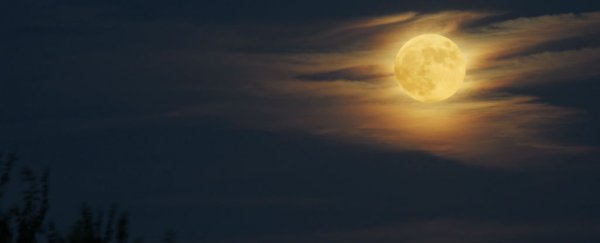The past few months have been very kind to us sky-watchers, with Africa's stunning 'ring of fire', a harvest eclipse, and an elusive black moon.
Now we get to see the Moon get huge and bright orange in the night sky, because a hunter's moon and a supermoon are set to combine on the night of October 15 to 16 in the northern hemisphere.
If you're having trouble keeping tabs on all the different types of 'moons' we've got now - blood moon, blue moon, black moon, anyone? - the only thing you really need to remember when it comes to a hunter's moon is how awesome the colour will be.
Sometimes referred to as a blood moon - because no one can decide on just one definition for all these fancy names - a hunter's moon rises much earlier in the evening than usual, creating a shorter gap between sunset and moonrise.
As Matt Williams explains for Universe Today, the Moon typically rises 50 minutes later each day, but the hunter's moon rises 30 to 35 minutes later, giving us more light during the transition from night to day.
Traditionally, that meant hunters and farmers had extra moonlight to work by - hence the name, hunter's moon.
The reason for this earlier rise is because the Moon's orbital path creates a more narrow angle with the evening horizon during the autumn equinox, which runs from late September to early December in the northern hemisphere, and between March and April in the southern hemisphere.
So why does it look so orangey red?
Well, in reality, a hunter's moon is just a regular full moon, so technically it's no bigger, brighter, or more colourful than any other full moon. But a really interesting illusion makes it appear that way to us in the night sky.
As EarthSky's Deborah Byrd reports, it's the location of the hunter's moon so close to the horizon that makes it look so big and orange:
"The orange colour of a moon near the horizon is a true physical effect. It stems from the fact that - when you look toward the horizon - you are looking through a greater thickness of Earth's atmosphere than when you gaze up and overhead.
The atmosphere scatters blue light - that's why the sky looks blue. The greater thickness of atmosphere in the direction of a horizon scatters blue light most effectively, but it lets red light pass through to your eyes. So a full moon near the horizon - any full moon near the horizon - takes on a yellow or orange or reddish hue."
Being so close to the horizon also tends to create the illusion of the hunter's moon being bigger than a regular moon, and this weekend it's going to look even bigger than that, because we've got that coinciding supermoon to consider.
Technically known as a full moon near perigee, a supermoon occurs when the moon is at its closest distance to Earth during its oval-shaped orbit. This results in the moon appearing larger than normal in the night sky.
Here's a comparison:
 Marco Langbroek/Wikimedia
Marco Langbroek/Wikimedia
In the northern hemisphere, this weekend's full moon - on the night of October 15 to 16 - is the first of this year's three full moon supermoons.
To watch, just follow Earthsky's awesome instructions:
"Clock time for this full moon - and every full moon - varies by time zone. For London, the Moon turns full at 5:23am BST on October 16, at which time the Moon shines in their western sky.
For the US, the Moon turns full on October 16 at 12:23am EDT - yet on October 15 at 11:23pm CDT, 10:23pm MDT and 9:23pm PDT."
If you're in the southern hemisphere and are feeling a bit left out, it's all good - you'll get your hunter's supermoon too. Because your autumn equinox starts in March instead of September, everything in this post applies to you then.
And if you don't have time to do some sky-watching this weekend, don't worry, there's something else coming up soon that you can do instead. November 14 is set to have the closest and largest full moon of 2016 - and it's also expected to be the largest full moon so far in the 21st century.
Mark your calendars now!
